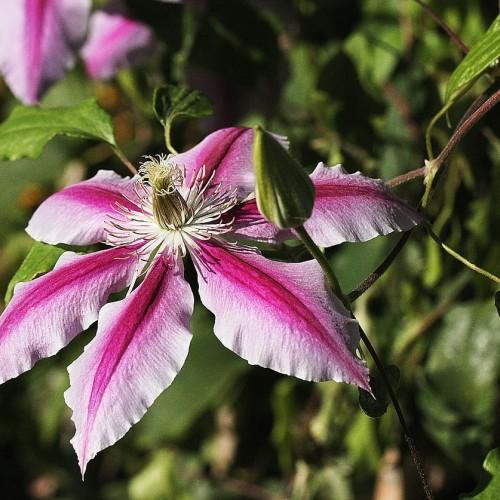
clematis
Clematis 'Pink Fantasy'
Cycle:
Perennial
Watering:
Average
Hardiness Zone:
4 - 8
Flowers:
Flowers
Sun:
Full sun,part shade
Leaf:
Yes
Growth Rate:
High
Maintenance:
Low
Care Level:
Medium
watering
Water Clematis 'Pink Fantasy' once every 7-10 days. Ensure that the soil is moist but not wet. If temperatures are extremely hot, increase waterings to once every 5 days. If weather is naturally cool and rainy, you may decrease waterings to once every 10 days to 2 weeks. For best results, it is recommended to water directly at the roots and not on the leaves of the plant. During dry and warm weather, it will be beneficial to mist the leaves with a spray bottle once or twice a week to simulate natural dew and encourage the growth of blooms.
sunlight
Clematis 'Pink Fantasy' is a flowering, deciduous climber that thrives best when planted in a location that receives at least 6 hours of direct sunlight per day. It blooms best in full sun, but can tolerate partial shade, particularly in hot climates. This plant appreciates a well-drained soil that is slightly acidic or neutral in pH. If the soil becomes too dry, many of the flowers may not bloom as profusely as expected. It is ideal to water the clematis deeply at least once a week, to encourage more blooms throughout the season.
pruning
Pruning Clematis 'Pink Fantasy' is often recommended to keep the plant healthy and promote more blooms. Pruning should be done in late winter or early spring before new growth appears. First, remove any dead or unhealthy stems, as well as any crossed branches. Then, look for any stems growing vertically, as these are the ones that produce the most blooms. Cut these down to 1 or 2 buds above soil level. If there are no vertical stems, cut the entire plant back to the ground. Also, remove any flowerheads once they have finished blooming to avoid over-fertilizing and promote even more flowers. Finally, apply a balanced fertilizer in spring to enhance growth and blooms.
Season
Hardiness Map
FAQ
Can Clematis plants grow in pots?
Yes, Clematis plants can definitely be grown in pots. When planting a Clematis in a pot make sure to use a larger size pot with drainage holes and fill it with a mix of well-draining potting soil and compost. Ensure to keep the root area cool and the pot in a sunny location while providing regular water and fertilization. Check the plant almost daily to make sure it is not becoming too dry. Clematis can do well in a pot and with the right care and conditions, they will thrive.
Are Clematis plants self-pollinating?
No, clematis plants are not self-pollinating. Clematis plants need pollinators such as bees, butterflies, moths and other insects to transfer pollen from the male anthers to the female stigma of the flower in order to produce viable seed. Pollination must also occur within relatively close proximity of the same species in order to create viable hybrid plants.
Can Clematis plants be grown as a houseplant?
Yes, Clematis plants can be grown as a houseplant. It is best to grow them in a pot with full sun and a soil that is rich in organic material and retains moisture. When potting the plant, place a stake or trellis next to the pot so that the vine can climb when it begins to grow. Be sure to water your Clematis plant regularly to keep it healthy and growing. Additionally, keep an eye out for pests and treat with natural insecticides as necessary.
Could Clematis plants survive in a colder climate?
Yes, Clematis plants can survive in colder climates with proper preparation. If planted in the fall, proper mulching should be done to protect the roots from cold temperatures. If planted in the spring, they should be watered frequently to help them adjust to the cooler temperatures more quickly. If temperatures drop below -20°C ( -4°F), additional measures may need to be taken such as the application of protective wraps and thermal insulation. Additionally, plants in exposed areas should be protected from the wind to prevent excessive dehydration. With the right measures in place, Clematis plants can easily survive in colder climates.
Could Clematis plants be grown in a greenhouse?
Yes, clematis plants can be grown in a greenhouse. Due to their vine-like growth habit and tropical native origins, clematis plants thrive in the moist and warm environment of a greenhouse. Clematis are generally grown from cuttings or from dividing existing plants, and benefit from regular pruning and fertilizing. They will also enjoy the indirect light of a greenhouse and the protection from strong winds and temperatures that the humidity and contained environment provides.
